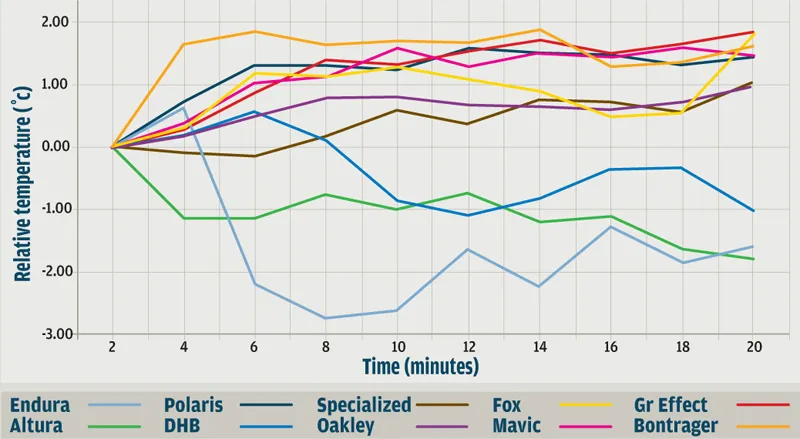On top of our usual exhaustive testing out on the trails, for our latest mountain bike jersey grouptest we took all of the tops to the Centre for Sport and Exercise Science (CSES) at Sheffield Hallam University to find out how cool they would keep us in standard conditions.
The Sheffield Hallam CSES is used by national governing bodies, such as British Cycling, to develop and support elite athletes. CSES senior sport and exercise science officer Rob Scaife (BSc Hons MMedSci) designed our protocols for this test.
We clamped a bike onto a turbo trainer inside the environment chamber – the dreaded sweatbox, a sealed room where you can control temperature and humidity levels. We set it to the climate of a hot UK summer’s day and used a fan to create windflow.
We wired up our reluctant tester, Guinea Pig Mat, with sensors to measure his skin temperature at various points on the upper body: pectoral, sternum, below the sleeve at the bicep, and just below the shoulder blade.
We also measured core body temperature with a sensor inside the ear, and the temperature on the outside face of the jersey to tell us how much heat was getting transferred outwards.
We then sent Guinea Pig Mat into the sweatbox and made him ride on the turbo at a medium intensity, measured with a heart rate monitor, for 20 minutes in each jersey.
After allowing the temperatures to stabilise over the first six minutes, we recorded the readings every two minutes. Mat also noted how hot he felt as he worked up a sweat.
We corrected the results to take account of any minor variations in temperature and/or ride intensity. We also weighed each jersey before testing and again immediately afterwards to find out how much moisture it had absorbed.
We allowed Guinea Pig Mat to cool down to a normal level between each test, mopped him off and regulated his drinking so that his bodyweight didn’t vary by more than 200g all day to keep everything as consistent as possible.
Wick it up
So, what were we looking for? These are all summer jerseys so we wanted them to keep us cool as we pedalled – the temperature results were straightforward and easy to interpret.
The moisture absorption results were more complicated. Is a jersey that absorbs a lot of sweat doing a good job? It’s taking plenty of sweat off your skin, but it might hold onto it for an age, like a sponge, getting heavy and uncomfortable.
A jersey that remains light while you’re working hard might be doing a fantastic job of wicking sweat away from your body and drying out fast, or it just might not be sucking up much moisture in the first place.
That means we had to interpret the moisture absorption results alongside our own perceptions in the sweatbox. Whether a jersey kept us feeling fresh or clammy was just as important as the figures.
Testing outside the lab
We did the environment chamber testing on top of all our usual real-life testing, not instead of it. We still got in heaps of riding out on the trails in all the clothing featured here.
Before doing any riding we weighed everything (weights relate to a ‘large’ sized garment, or 34in waist in some of the shorts). It’s not that we think a few grams either way is going to affect your speed that much, it’s just to give you an extra indication of how the clothes are likely to feel when you wear them.
We inspected all the test products, paying particular attention to the characteristics of the fabric, the build, and the quality of all the features: vents, pockets, zips and so on. Then we hit the trails, wearing everything in as wide a variety of conditions as possible.
We jacked up the intensity to find out how the fabrics felt when we got damp, whether they got heavy with sweat, spray or rain, and how quickly they dried out. We included high-mileage rides to find out how well the shorts’ pads performed and whether any jersey seams chafed over the course of the day.
Once we were happy we’d tested each item exhaustively, we passed it onto the next tester to do the same, and then we gave them all a final inspection to find out how well they’d survived over the test period.
Results
The table below shows the mean relative temperature changes of our sensors for each jersey over our time in the chamber. What does that mean? Essentially, it shows how cool each jersey kept us.
We started off with our baseline figures for each jersey: the temperatures of each of the six sensors when we walked into the environment chamber. Then we recorded the temperature of each sensor every two minutes from six minutes up to 20 minutes on the bike.
The figure given for each jersey is the average rise or fall in those temperatures compared with the starting figures. A negative figure shows that our average temperature fell during our time in the sweatbox: a good thing for hot summer riding.
A positive figure shows that our average temperature increased, and by how much. We had hundreds of measurements to work from, but this table gives you a good overall indication of how each jersey performed.

The jerseys
- Endura Hummvee, £35
- Altura Asymetrix, £40
- Polaris Blake, £35
- DHB Finchdean, £56
- Specialized Trail, £40
- Oakley Dreaded, £40
- Fox Live Wire, £30
- Mavic Notch, £40
- Ground Effect Manta Ray, £38
- Bontrager Rhythm Comp, £40
Look out for reviews of all these tops on BikeRadar soon.

